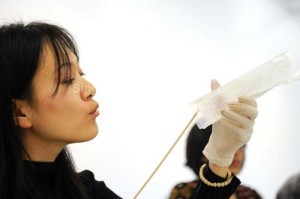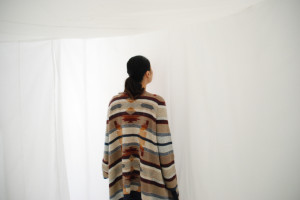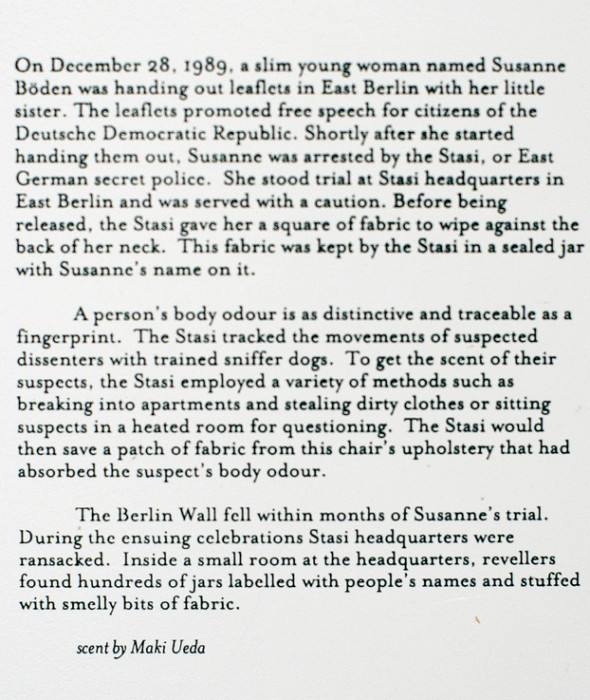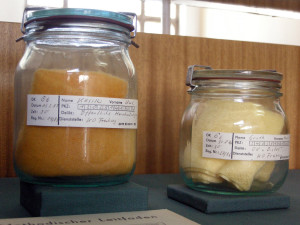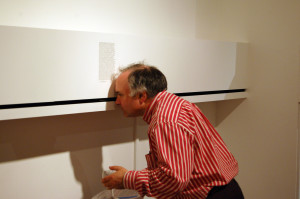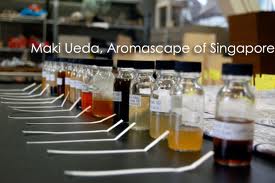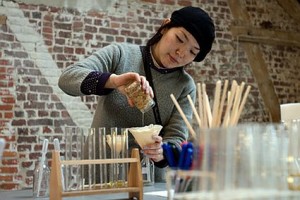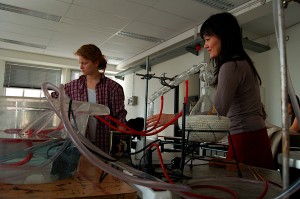Contemporary Western culture privileges the visual over all other senses. If you live in a city like I do, there is an unrelenting profusion of images on television sets in taxicabs, gas stations, and restaurants. Vision is power; we keep building taller and taller buildings so we can stand on top of them and dominate the surroundings with our eyes.
Smell is often disparaged as the poor cousin of seeing, as we no longer need to rely on it for our daily survival the way we did when we were compelled to hunt for our food and were prey to other carnivores in the wild. The sensitivity we once had to non-visual stimuli such as touch and smell have fallen away over the millennia; as a consequence, so has our connectedness to our environment and, most alarmingly, to each other.
In the work of Rotterdam-based artist, Maki Ueda, I see efforts to make us reconceive our relationship to the five senses. I wrote about her work last year on my blog Mad Perfumista when she created an installation at V2 Institute for Unstable Media called “Olfactoscape,” featuring a round tent into which the deconstructed notes of Chanel No. 5 were diffused one by one, revealing the perfume notes like chords in a symphony. All photos are © Maki Ueda.
Olfactoscape: Deconstructing Chanel No. 5, installation view, V2 Institute of Unstable Media
Olfactoscape: Deconstructing Chanel No. 5, installation view, V2 Institute of Unstable Media
As I probed deeper into Ueda’s project, I found an artist who has been very prolific in the last decade making works linking vision with taste and smell, as well as teaching at art and design schools. In 2009, the Willem de Kooning Art Academy in Rotterdam offered a workshop called “How to confuse our senses?” Through this class, Ueda aimed to show that what we see is only part of a much larger inquiry into how we acquire knowledge about the world. The confusion that ensues when you see something and smell something else is in itself an aesthetic experience propelling you from the known into the unknown. In the workshop description, she writes:
Kohlrabi tastes like cabbage. Hyacinth smells like jasmine and rose. We come up with such brilliant connections often when we smell (or taste) without seeing. It tells us how the sense of seeing influences the other senses. An object that looks like an apple has to smell like an apple, according to our eyes. Otherwise we get confused.
In 2008, Ueda took part in “If There Ever Was: An Exhibition of Extinct and Impossible Smells” at the Reg Vardy Gallery. Other participants included well-known perfumers such as Bertrand Duchaufour, Mark Buxton, Christophe Ladaumiel, and Geza Schoen who were all asked to compose unique fragrances. Ueda was given the fictional story of a young woman living in Cold War Berlin, whose bodily scent was taken from her when she was arrested by the Stasi then released. Her scent became part of a huge archive found after the fall of the Berlin Wall at Stasi headquarters. Cloths in glass jars held the scent map of suspected dissenters, and were used by the police to track down their whereabouts. Ueda, inspired by this story, chose to distill and present her own smell.
Essay for Maki Ueda’s Scent Piece at If There Ever Was, Reg Vardy Gallery
Jars containing scents of suspected dissidents at the Stasi Headquarters in Berlin.
Installation view, Maki Ueda at If There Ever Was, Reg Vardy Gallery
As part of the Urban Explorer’s Festival in Dordrecht, The Netherlands, Ueda led an olfactory boat tour through the canals of this old Dutch City called “Smell X Illusion.” On most tours, we expect endless narration of the stories contained in each of the streets, buildings, and alley ways. These stories emanate from loudspeakers and bullhorns, during which the history of a place becomes a verbal assault of dates and events. Not in the hands of Maki Ueda though; during the boat’s course through the city, she used paint sprayers and air compressors to spray “possible and impossible” odors such as fabric softener, rose, beer, cognac, Chanel No. 5, seaweed and pizza. Ueda encourages a unique, interiorized experience of the city whose story is written as odors waft over us and disappear.
Smell X Illusion, Urban Explorers Festival, Dordrecht, The Netherlands
Smell X Illusion, Urban Explorers Festival, Dordrecht, The Netherlands
Maki Ueda’s most recent challenge: to create “navigational scents” for a Buddhist pavilion in Japan. The project is called “Invisible White” and is made in collaboration with architect Makoto Yokomizo. It opened to the public in July 2013, and here is Ueda’s description of the project:
It's a void space dedicated for touching, hearing, and smelling. The architect designed a semi-darkness space that makes you feel like "endless space", and I made the scent diffusion system for it. As you walk into the space you cannot see at instance, and automatically you switch your priority to hearing, touching, and smelling. As you get used to the darkness you see no end in the space. There's no object but an environment. As you walk in the space you smell differently – 3 principle smells are used here like RGB for monitors. Thus smells navigate you in the space. There's no meaning given to the smells, but it's you who give them. The focus is your sense of smell and orientation.
Invisible White by Maki Ueda and Makoto Yokomizo at the Okamura Garden Court Show Room, Tokyo. Photo: Motoko Kamata
I was lucky enough to ask Maki Ueda a few questions over email about her artistic practice, and here is the interview below.
KC: Your work was featured in "If There Ever Was" along with several other famous “noses”. How did you feel being in their company? The work you created for the show–body odor of political suspects in East Germany–is darkly haunting and very different from your other work. Can you talk about the motivation behind making it?
MU: When I got this offer I was truly fascinated because it's in the context of contemporary art and not the perfume art. I think these are two totally different things. I was rather surprised but also proud that I was one of the few conventional artists invited. In this exhibition you do not have to look from the perspective if she or he is a professional perfumer or a conventional artist. Everything was in coherence. It owes to the curatorial quality of Robert Blackson. The theme 'body odour' was rather suggested by him than I picked. I trusted his sense.
KC: You did a smell scape project in Singapore where you distilled the tastes and odors of local foods and substances and then displayed the distilled scents at the Singapore Art Museum. You have also done a boat tour in the Netherlands called SMELL X ILLUSION where smells were diffused into the air. These projects remind me a lot of the Situationist International's idea of psychogeography and the dérive, which Guy Debord defines as "a mode of experimental behavior linked to the conditions of urban society: a technique of rapid passage through varied ambiances."
MU: I actually did not know about Situationist International. I guess many artists work on the theme "city and scents" in different ways. I find it fascinating. Making olfactory art is like making a composition of music. If two different composers make music pieces of Donau, they would sound different. I think if other olfactory artists make works under the theme of "scents of Singapore", the concept, method, and realization would be totally different, and that should be respected.
KC: What is the most important olfactory memory for you?
MU: I really liked the home smell of my grandpa & grandma. They lived far away so I visited them seldom, and the house does not exist anymore, but I still clearly remember it.
KC: I am intrigued by your class "How to confuse our senses." Many people are not comfortable with confusion, with the idea of seeing something and smelling something else. Why is this important for you?
MU: I chose this theme to show them what the olfactory art can do. One can add the orange smell to the painting of orange. Smell can be used to intensify the experience like this, but I think that's too easy. I want to challenge all the possibilities of the sense of smell by my art.
For more on Maki Ueda’s works, you can go to any of the following websites.
Twitter: @makiueda
–Katherine Chan aka Mad Perfumista, Guest Contributor
Editor’s Note: This is Katherine’s second guest post for CaFleureBon. Her previous piece on artist Anicka Yi can be found here.

